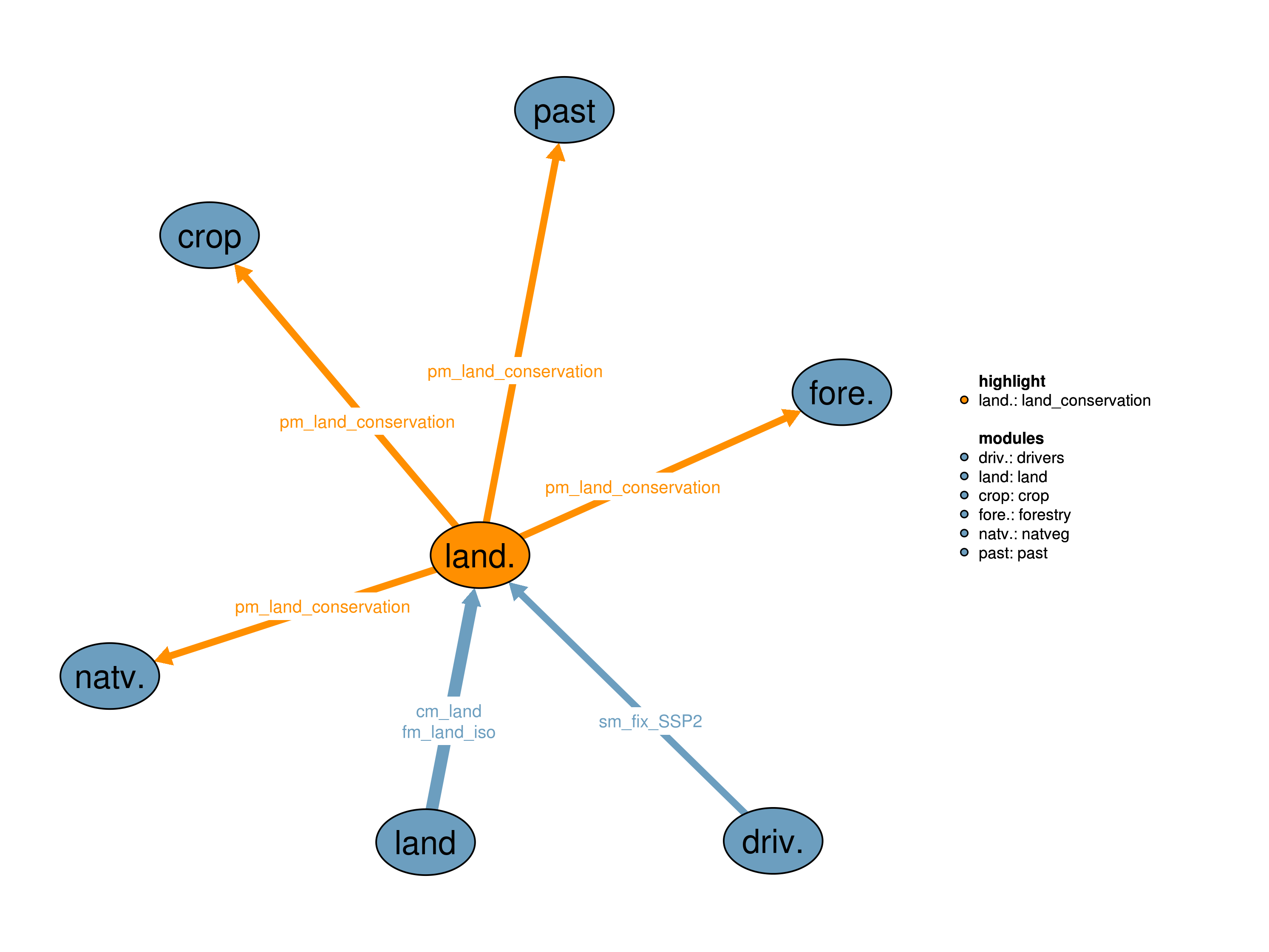The land conservation (land_conservation) module initialises land under legal protection for all land types, and provides future options for land conservation based on conservation priority areas. Based on the land area of the different land-use types (pcm_land) from the previous time step, this module also calculates restoration requirements to fulfil land conservation targets. Both the information on the protection of remaining land areas as well as information on restoration is transferred to the other land modules via the interface pm_land_conservation.

| Description | Unit | A | |
|---|---|---|---|
| fm_land_iso (t_ini10, iso, land) |
Land area for different land pools at ISO level | \(10^6 ha\) | x |
| pcm_land (j, land) |
Land area in previous time step including possible changes after optimization | \(10^6 ha\) | x |
| sm_fix_SSP2 | year until which all parameters are fixed to SSP2 values | \(year\) | x |
| Description | Unit | |
|---|---|---|
| pm_land_conservation (t, j, land, consv_type) |
Land protection and restoration for all land types | \(10^6 ha\) |
The realization initialises land stocks reserved for land conservation across grassland, forest and other land pools. Land reserved for area-based conservation is derived from WDPA and is based on observed land conservation trends. In 1995, the total area under land conservation (across all land types) in the input data set is 864.31 Mha and, by 5-year time steps, increases to 1662.02 Mha in 2020 (13.06 % of the total land area, excluding inland water bodies under protection). After 2020 land conservation is held constant at 2020 values. The protected area based on WDPA includes all areas under legal protection meeting the IUCN and CBD protected area definitions (including IUCN categories Ia, Ib, III, IV, V, VI and ‘not assigned’ but legally designated areas). Natural vegetation (natveg) and grassland (‘past’) within protected areas cannot be converted to other land types. On top of the WDPA baseline protection, there are future options to protect different conservation priority areas such as biodiversity hotspots (BH), centers of plant diversity (CBD), Intact Forest Landscapes (IFL) and last of the wild (LW), taken from Brooks et al. (2006). Future land conservation is distributed proportionally across natural vegetation types (primary forest, secondary forest and other natural land).
Limitations Land cover in the WDPA baseline data is estimated based on ESA-CCI land-use/land-cover maps from 1995 to 2020, while land pools in MAgPIE are intialised based on LUH2v2 data (forest areas are additionally harmonised with FAO data). This leads to slight mismatches in some areas.
| Description | Unit | A | |
|---|---|---|---|
| f22_consv_prio (j, consv_prio22, land) |
Conservation priority areas | \(10^6 ha\) | x |
| f22_wdpa_baseline (t_all, j, land) |
Initial protected area as derived from WDPA until 2020 | \(10^6 ha\) | x |
| i22_land_iso (iso) |
Total land area at ISO level | \(10^6 ha\) | x |
| p22_add_consv (t, j, consv22_all, land) |
Addtional land conservation in conservation priority areas | \(10^6 ha\) | x |
| p22_conservation_area (t, j, land) |
Total land conservation area for all land types | \(10^6 ha\) | x |
| p22_conservation_fader (t_all) |
Land conservation fader | \(1\) | x |
| p22_country_dummy (iso) |
Dummy parameter indicating whether country is affected by selected land conservation policy | \(1\) | x |
| p22_country_weight (i) |
Land conservation country weight per region | \(1\) | x |
| p22_other_restore_pot (t, j) |
Potential other land restoration area | \(10^6 ha\) | x |
| p22_past_restore_pot (t, j) |
Potential pasture restoration area | \(10^6 ha\) | x |
| p22_secdforest_restore_pot (t, j) |
Potential secondary forest restoration area | \(10^6 ha\) | x |
| s22_conservation_start | Land conservation start year | x | |
| s22_conservation_target | Land conservation target year | x | |
| s22_restore_land | If land restoration is allowed | \(0=no 1=yes\) | x |
| s22_shift | number of 5-year age-classes corresponding to current time step length | \(1\) | x |
| description | |
|---|---|
| age | Population age groups |
| cell(i, j) | number of LPJ cells per region i |
| consv_prio22(consv22_all) | Conservation priority areas |
| consv_type | Type of land conservation |
| consv22_all | All conservation options |
| forest_land(land) | land from which timber can be taken away |
| i | all economic regions |
| i_to_iso(i, iso) | mapping regions to iso countries |
| iso | list of iso countries |
| j | number of LPJ cells |
| land | Land pools |
| land_natveg(forest_land) | Natural vegetation land pools |
| policy_countries22(iso) | countries to be affected by land conservation policy |
| t_all(t_ext) | 5-year time periods |
| t_ini10 | Time periods with land initialization data |
| t(t_all) | Simulated time periods |
Patrick v. Jeetze
09_drivers, 10_land, 22_land_conservation, 30_crop, 31_past, 32_forestry, 35_natveg